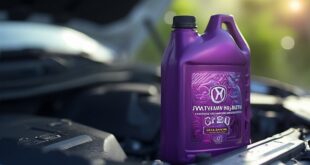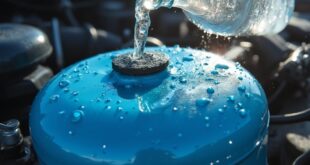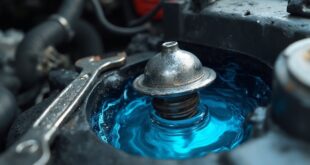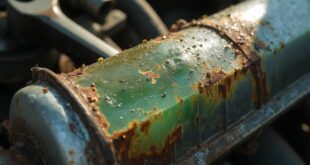To flush your car's radiator, start by ensuring the engine is cool. Remove the radiator cap and drain the old coolant using a catch pan. Next, fill the radiator with distilled water, run the engine for ten minutes to circulate, then drain again. Finally, add new coolant using a funnel, ensuring you don't overfill. Keep an eye out for signs of radiator issues like overheating or debris. There's more to effectively handle this process, so keep going!
Preparation and Safety for Flushing the Radiator
Before you begin flushing your car's radiator, it's important to verify the engine is completely cool to avoid injuries.
Gather your supplies—coolant, a funnel, and a catch pan—before starting. Wearing protective clothing, gloves, and eyewear is vital for safety.
Once the engine has cooled, open the hood and confirm the work area is clear of pets. This helps prevent any accidents while you work.
Double-check that you have everything you need within reach.
With proper preparation, you'll make the flushing process smoother and safer, allowing you to focus on getting your vehicle back in top shape.
Draining the Radiator
Start by draining the radiator to remove old coolant and any debris that may have accumulated. Here's how to do it efficiently:
- Remove the radiator cap to release pressure.
- Locate the drain petcock at the radiator's corner.
- Position a pan beneath the petcock to catch the coolant.
- If needed, remove the lower hose for complete drainage.
- Transfer the old coolant into a suitable container for recycling.
Once drained, reinstall the petcock or hose securely.
This step is essential in maintaining your vehicle's cooling system, ensuring it operates smoothly without any blockages or contaminants.
Flushing the Radiator
After you've successfully drained the radiator, the next step is flushing it to remove any remaining debris and contaminants.
Pour distilled water into the radiator until it's full. Then, start the engine and let it run for about ten minutes. This process circulates the water, helping to dislodge any buildup.
Afterward, shut off the engine and allow it to cool completely. Once cooled, drain the water out just like you did with the coolant.
This flushing method is effective and doesn't require fancy equipment, ensuring your radiator stays in top shape for peak performance.
Adding New Coolant
Now that you've flushed the radiator, it's time to add new coolant to guarantee your engine runs smoothly.
Here's what you need to do:
- Check your owner's manual for the correct antifreeze amount.
- Use the manufacturer-recommended coolant type for peak performance.
- Grab a funnel to avoid spills while pouring.
- Fill the overflow tank to the maximum line; don't overfill.
- If your vehicle has an expansion tank, fill it to the max sign.
Once you've added the coolant, run the engine for a few minutes to circulate it, and verify everything's in working order.
Signs That a Radiator Flush Is Needed
Recognizing the signs that your radiator needs a flush is essential for maintaining your vehicle's health.
If you notice your engine overheating, it may indicate coolant contamination or clogs. Keep an eye out for debris floating in the coolant, as this signals a buildup that requires attention.
Steam or unusual smells coming from the engine bay are also red flags. Additionally, if you hear strange noises or spot coolant leaks, don't ignore them—these issues need immediate inspection.
Regular checks can prevent further complications and keep your engine running smoothly.
Recognizing Cooling System Issues
When you notice coolant leaks or your engine starts to overheat, it's crucial to pay attention, as these could signal underlying cooling system issues. Ignoring these signs can lead to severe damage.
Look out for:
- Coolant pooling under your vehicle.
- Overheating when idling or driving.
- A defective radiator cap causing pressure loss.
- Rust or debris in your coolant.
- Low coolant levels indicating potential leaks.
Address these symptoms promptly to avoid costly repairs.
Regular checks and maintenance can help you catch problems early, ensuring your cooling system runs efficiently and your engine stays safe.
Maintenance Tips and Cost Considerations
Catching cooling system issues early can save you from expensive repairs down the line.
Regularly check your coolant levels and inspect hoses for temperature differences. Schedule a radiator flush every five years or 100,000 miles to maintain efficiency. Always use the manufacturer-recommended coolant type to avoid complications.
Keep an eye on coolant condition; rust or debris signals a need for action. Budget for coolant replacement and system flushes to prevent costly repairs later.
Frequently Asked Questions
How Often Should I Check My Coolant Levels?
You should check your coolant levels regularly, ideally every month or before long trips. This helps prevent overheating and guarantees your cooling system runs efficiently. Don't forget to inspect for leaks while you're at it!
Can I Use Tap Water Instead of Distilled Water?
You shouldn't use tap water for flushing. It contains minerals and impurities that can harm your radiator. Stick with distilled water to guarantee peak performance and longevity for your cooling system. Your engine will thank you!
What Tools Do I Need for Flushing the Radiator?
To flush the radiator, you'll need a radiator cap remover, a drain pan, a funnel, and distilled water. Having protective gloves and eyewear is smart, too, to keep you safe during the process.
Is It Safe to Flush the Radiator in Cold Weather?
Flushing the radiator in cold weather can be safe if you guarantee the engine is cool and avoid ice buildup. Just take extra precautions to prevent slipping and wear appropriate protective gear during the process.
Can I Flush the Radiator Without a Garage?
Yes, you can flush the radiator without a garage. Just make certain you choose a safe outdoor location, wait for the engine to cool, and have all your supplies ready to make the process efficient and safe.
 Car Service Land Coupons for Oil change, Tires, Wheel alignment, Brakes, Maintenance
Car Service Land Coupons for Oil change, Tires, Wheel alignment, Brakes, Maintenance




